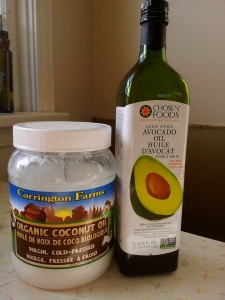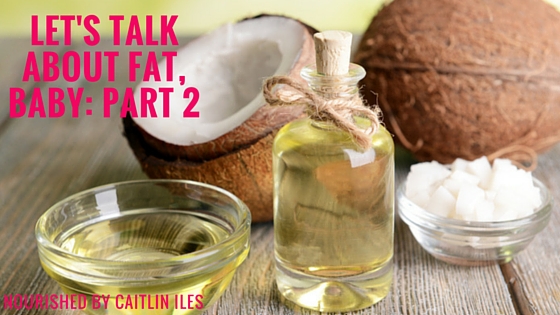Hi friends! If you joined me on Monday for Part 1 of this series (check it here) you’re already well versed in which fats to avoid and why. Now we can dive into the fun stuff and start talking about all the delicious and nutritious fats you can start incorporating into your diet today! It’s a pretty long one, so I’m going to divide it into 2 more parts, so as not to bore you. Let’s get started!
Fats to Love
Coconut Oil
Great for: Baking, high heat cooking, and eating by the spoonful
If you’ve ever read any of my posts or recipes before you know how much I love coconut oil. It’s probably the fat I eat the most of on any given day
Great for high heat cooking and baking. Coconut oil has anti-viral, anti-bacterial, and anti-fungal properties thanks to its caprylic and lauric acid content. It also contains medium chain triglycerides (MCTs), a type of fat that provides energy for the liver and which increase the beta-oxidation of stored fat, to help us maintain our svelte figures. Look for virgin, cold-pressed, and organic sources. Costco sells a delicious and ridiculously affordable brand called Carrington Farms.

Here are a couple excellent cooking and baking alternatives. Certified GMO free avocado oil and organic cold-pressed coconut oil. Yum!
Avocado Oil
Great for: High heat cooking, salad dressings, baking that calls for liquid oil
A major portion of the fat found in avocado oil comes from phytosterols and polyhydroxylated fatty alcohols (PFAs), two other fats that helps modulate the inflammatory response in the body. Like olive oil, avocado oil also contains oleic acid, which not only helps lower blood pressure, but also helps increase absorption of fat-soluble molecules, such as carotenoids. Avocados contain an impressive array of carotenoids (phytonutrients) and the proper fats required to properly absorb these important nutrients. Sounds like a pretty perfect food to me!
Olive Oil
Great for: Low-medium heat cooking, salad dressings, baking (if you don’t mind a richer taste)
When buying olive oil, you want to look for Extra Virgin on the label. Olive oil that is labeled as such comes from the first press of the olives and contains the highest amount of phytonutrients (especially polyphenols) that have been shown to have anti-inflammatory effects in the body. Inflammation is one possible root cause for a myriad of bodily imbalances, so we want to eat as many foods that promote a healthy inflammatory response as possible. Olive oil is made up of about 70% oleic acid, which has been shown to help lower blood pressure.
Hemp Oil
Great for: Dressings, any unheated preparations
Hemp oil contains a ratio of omega-6 to omega-3 oil of 4:1, which as we discussed in part one is within the optimal ratio to prevent a dysfunctional inflammatory response. So long as you’re maintaining a proper balance of these fats by avoiding non-organic, overly processed vegetable oils, hemp oil can be a great addition to a healthy diet. Because this oil contains mostly polyunsaturated fatty acids (PUFAs) we want to avoid cooking with it to preserve its health benefits and prevent rancidity. I would store hemp oil in an opaque container in the fridge to ensure peak freshness and prevent the possibility of spoilage.
Well folks, that’s all for today! Next time we’ll cover walnut and flax oils, animal fat, cocoa butter, and organic/grassfed butter. I hope you have a splendid evening. Until next time!
Cait 🙂
Check out Part 3 here!




Trackbacks/Pingbacks